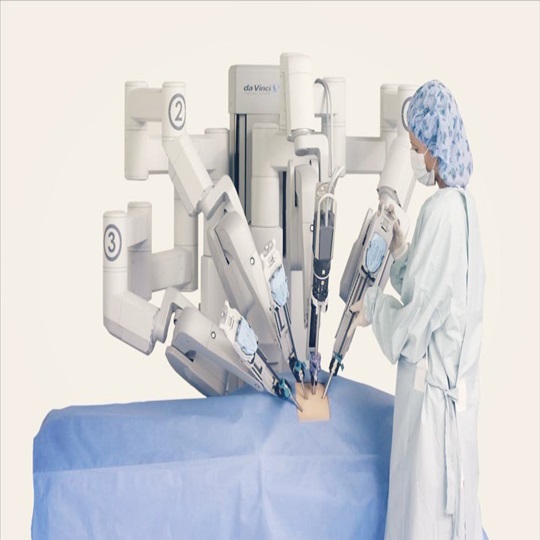Robotic Surgery (Robot-assisted laparoscopic Surgery)
Robotic Surgery | Robotic surgery is one of the latest innovations in minimally invasive surgical techniques. Short recovery time, less postoperative pain, the ability to perform more delicate surgery due to the articulation capacity of the instruments used, and the advantage of the surgeon performing the surgery while sitting at the console make this surgical approach advantageous.
Robotic Surgery | Unlike laparoscopic surgery, the surgeon performs the surgery with advanced technological instruments controlled by the console. It allows complicated cases such as pelvic organ prolapse, myoma, endometriosis, hysterectomy in abnormal uterine bleeding, myomectomy, cyst removal, gynecological cancer surgeries to be performed with less complication risk and easier recovery process.
Duration of Surgery: The duration of robotic hysterectomy can usually vary depending on the patient’s condition, the type of surgery to be performed, and the surgeon’s experience. However, it usually takes between 1 and 4 hours on average.
Time to Stand Up: Robotic Surgery | Patients can usually stand up within a few hours after robotic hysterectomy. However, the full recovery process and return to normal daily activities may vary depending on the patient’s condition. Light activities can usually be resumed within a few days after surgery, and full recovery can be completed within 4 to 6 weeks.
Procedure of Surgery: Robotic Surgery | Robotic surgeries are a minimally invasive procedure in which the surgeon controls the robotic surgical system remotely using a console. The surgeon sits at the console and the robotic arms enter through small incisions to perform the procedure. This method can offer less blood loss, less pain, and a faster recovery process compared to traditional open surgery.
Post-Operative Follow-Up: Robotic Surgery | Patients are usually monitored regularly by their doctors for several weeks after robotic hysterectomy. Regular check-ups are important to monitor possible complications and provide necessary supplements throughout the recovery process.
The Impact of Robotic Surgeries on Daily Life
Faster Recovery: Robotic Surgery | Robotic surgery usually offers a faster recovery time than traditional open surgery. With smaller incisions and minimal tissue damage, patients can usually return to normal daily activities in a shorter period of time.
Less Pain and Discomfort: The smaller incisions and more precise procedure techniques used in robotic surgery can reduce post-operative pain and discomfort. This allows patients to have a more comfortable recovery.
Less Blood Loss: The techniques used in robotic surgery usually cause less blood loss. This reduces the risk of post-operative complications and helps the patient recover faster.
Less Scarring: The small incisions used in robotic surgery usually cause less visible scarring. This can help patients experience less aesthetic anxiety and feel better after the surgery.
Less Hospital Stay: Robotic surgery usually requires shorter hospital stays. This allows patients to return home and return to their daily lives more quickly.
Better Oncological Outcomes: Some studies show that robotic surgery can provide better oncological outcomes in cancer treatment than traditional open surgery. Thanks to more precise surgical techniques, complete removal of cancerous tissue and prevention of cancer spread can be performed more effectively.
Fewer Complications: Robotic surgery is generally associated with fewer complications. This can be a safer surgical option for cancer patients and can positively affect the healing process.
Individualized Treatment Approach: Robotic surgery allows the surgeon to manage the operation more precisely. This allows for an individualized treatment approach to be adopted for each patient’s condition.
Challenges and Advantages of Robotic Surgeries
Challenges:
High Cost: The high cost of robotic surgical systems may limit the widespread use of this technology and create accessibility issues for some healthcare institutions.
Requirement of Surgical Experience: Robotic surgery requires surgeons to receive special training. This requires an additional learning curve for surgeons to use robotic systems effectively.
Advantages:
Less Invasive: Robotic surgery is a less invasive option than traditional open surgery. This allows patients to benefit from many advantages, such as less blood loss, less pain, and a faster recovery.
Better View and Control: Robotic surgery systems provide surgeons with better view and more precise control. This allows surgeons to make more controlled movements and can reduce the risk of complications.
Shorter Hospital Stay: Robotic surgery usually requires shorter hospital stays. This allows patients to return home and return to their daily lives more quickly.
Better Cosmetic Results: Robotic surgery usually requires smaller incisions, which can leave less visible scars. This allows patients to be more aesthetically satisfied.
These details help us understand the challenges and advantages of robotic surgery.
Assoc. Prof. Dr. Esra Özbaşlı and Robotic Surgery
Robotic Surgery | Assoc. Prof. Dr. Esra Özbaşlı completed her Robotic Surgery training at the da Vinci Training Center IRCAD-EITS in Strasbourg, France in 2013 and became a da Vinci Console Surgeon.
Associate Professor Esra Özbaşlı’s research and published articles in the field of robotic surgery can be found in the medical literature.







